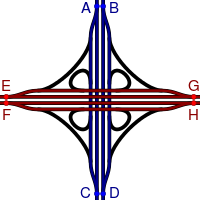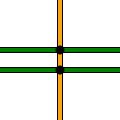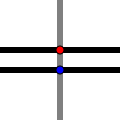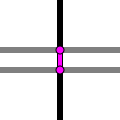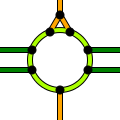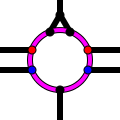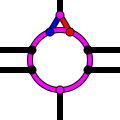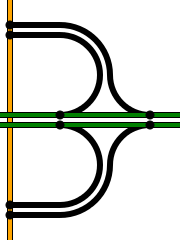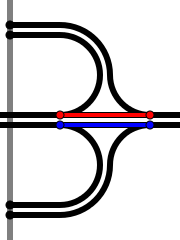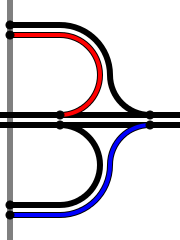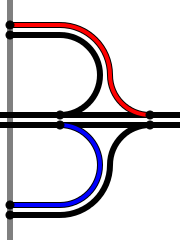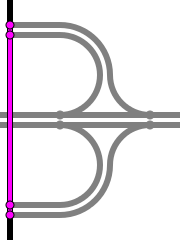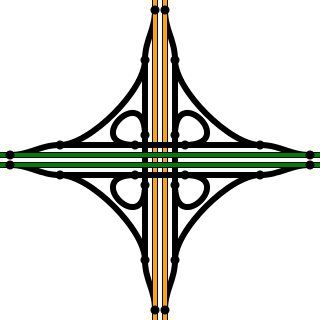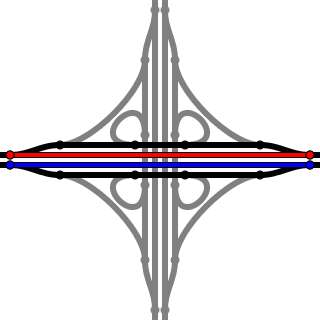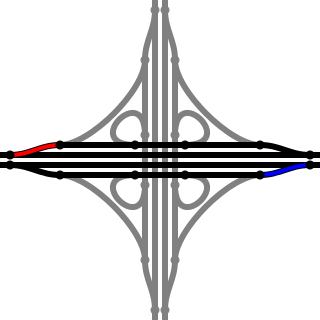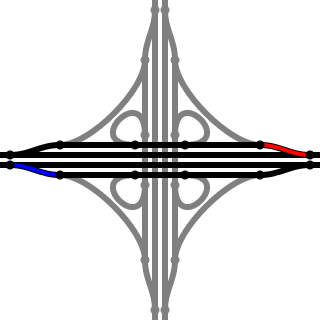Pl:Relation:tmc:point
| Opis |
|---|
| Lokalizacja punktów kanału komunikatów drogowych. |
| Grupa: Drogi |
| Człony |
| Status: zaproponowany |
| Narzędzia |
Relacja tmc:point oznacza pojedynczą lokalizację punktu kanału komunikatów drogowych (Traffic Message Channel), który może być jako niezależny punkt nie podłączony do sieci drogowej, punkt pośredni wzdłuż pojedynczej drogi, taki jak most lub tunel, lub skrzyżowanie kilku dróg.
Opis
Każda lokalizacja punktu TMC, która jest jednoznacznie identyfikowana przez identyfikator kraju, kod tabeli i kod lokalizacji z listy kodów lokalizacji, mająca klasę "P" dla punktu, powinna odpowiadać dokładnie jedna relacja punktu TMC w OSM.
Niektóre miejsca, na przykład skrzyżowania autostrad, mają więcej niż jeden kod lokalizacji - po jednym na każdą autostradę. Powinny one być mapowane przy użyciu więcej niż jednej relacji punktowej TMC, po jednej dla każdego kodu lokalizacji.
Tagi
| Klucz | Wartość | Objaśnienie | Opis |
|---|---|---|---|
| Tagi podstawowe | |||
| type | tmc:point | Indicates that this relation represents a TMC point location. | tmc:point |
| table | country ID and table code | Country ID (cid) and table code (tabcd) of the TMC Location Code List which contains this location. The values are separated with a colon in the form "{cid}:{tabcd}". | 58:1 |
| version | table version | Version of the TMC location table according to which this point has been mapped. | 13.0 |
| lcd | location code | Location code in the range 1 - 63487 of this TMC point. | 12345 |
| class | location class, type, subtype | Class, type and subtype of this TMC point in the form "{class}{type}.{subtype}". For point locations {class} is always the letter P, while {type} and {subtype} are numbers. See TMC/Location Code List/Location Types#Points for a list of possible values. | P1.2 |
| Nazwy i odniesienia | |||
| name | name | Name of this TMC point. This is usually the name found in the location table in the field n1id, but can also be modified, if appropriate. | Hannover-Ost |
| intersects | name of intersecting road | If this point marks an intersection or motorway junction, and the intersected road has a name, this tag may contain the name of the intersected road. This is usually found in the field n2id of the location table. | Rötgesbütteler Landstraße |
| road_name | road name | Name of the road to which this TMC point point belongs. This can be found in the field rnid of the location table, but modifications are possible. | Friedensallee |
| road_ref | road reference number | Reference number of the road to which this TMC point point belongs. This can be found in the field roadnumber of the location table. | A 23 |
| junction_ref | junction reference number | Locations such as motorway junctions usually have a reference number which enumerates the junctions along a motorway. This can be found in the field junctionnumber of the location table. | 17 |
| Obecność w zależności od kierunku | |||
| present | positive / negative / both | Indicates whether this TMC point location (such as a service or rest area) is present / available to drivers driving in either direction or not. The default is "both". Other values indicate whether the driver must be driving in positive or negative TMC direction to access / use this feature. | positive |
| Przesunięcia | |||
| pos_offset | positive offset | Location code of the neighbouring TMC point in the positive road direction. This can be found in the field pos_off_lcd in the location table. | 12346 |
| neg_offset | negative offset | Location code of the neighbouring TMC point in the negative road direction. This can be found in the field neg_off_lcd in the location table. | 12344 |
| Linki do innych lokalizacji TMC | |||
| road_lcd | road location code | Location code of the TMC road to which this TMC point belongs, if any. This can be found in the field roa_lcd in the location table. | 1234 |
| seg_lcd | segment location code | Location code of the TMC segment to which this TMC point belongs, if any. This can be found in the field seg_lcd in the location table. | 4321 |
| area_lcd | area location code | Location code of the TMC area to which this TMC point belongs, if any. This can be found in the field pol_lcd or oth_lcd in the location table. | 123 |
Człony i role
Relacja tmc:point może zawierać dwa różne rodzaje elementów: węzły skrzyżowania i linii wzdłuż drogi/jezdni używane do nawigacji oraz elementy infrastruktury, takie jak parkingi lub stacje benzynowe, na które mogą wpływać komunikaty TMC. Role służą do rozróżniania elementów na głównej jezdni oraz na drogach i różnych rodzajach infrastruktury. Następnie opisują po której stronie drogi znajdują się te elementy, w dodatnim, albo ujemnym kierunku TMC, albo w obu.
Role są generalnie rodzaju {direction}:{description}, gdzie {direction} jest jedną z wartości "![]() positive", "
positive", "![]() negative" lub "
negative" lub "![]() both" i wskazuje po której stronie drogi ten element jest zlokalizowany, tj. czy może być używany przez kierowców jadących w kierunku dodatnim, ujemnym lub dowolnym.
both" i wskazuje po której stronie drogi ten element jest zlokalizowany, tj. czy może być używany przez kierowców jadących w kierunku dodatnim, ujemnym lub dowolnym. {description} wskazuje, czy element ten jest częścią drogi, czy infrastruktury. Poniższa tabela zawiera niektóre możliwe wartości:
Przykłady
Poniższe przykłady pokazują, które elementy (węzły i linie) należy uwzględnić w relacji punktów TMC i jakie role należy przypisać do tych elementów. Zdjęcia pokazują sytuację dla ruchu prawostronnego.
Połączenie między drogą segregowaną i niesegregowaną
This example shows a junction between a segregated road (green) with a non-segregated road (orange). The positive direction of the segregated road is to the left, and of the non-segregated road to the top. If both roads are in the TMC road network, this junction has two TMC location codes, since it is an element of two roads, and therefore should be mapped using two TMC point relations, one for each location code. In the following the members of these TMC point relations are shown.
| Punkt TMC na wydzielonej drodze | |
|---|---|
| A driver on the segregated road passes by only one node at which he can enter or leave the road, either the red or blue node, depending on his driving direction. The red node (positive driving direction) is added to the TMC point relation with role positive, while the blue node (negative driving direction) is added with role negative. | |
| Punkt TMC na niesegregowanej drodze | |
| The nodes where one can enter or leave this road are added to the TMC point relation with role both, since they are passed by in either driving direction. The way between these two nodes is also added to the relation with role both. Here the roles can also be omitted, since both is the default if there is only one role in the relation. | |
Rondo między drogą segregowaną i niesegregowaną
In this example the junction between the segregated road (green) and the non-segregated road (orange) has been replaced by a roundabout. The positive direction of the segregated road is to the left, and of the non-segregated road to the top. If both roads are in the TMC road network, this junction has two TMC location codes, since it is an element of two roads, and therefore should be mapped using two TMC point relations, one for each location code. In the following the members of these TMC point relations are shown.
| Punkt TMC na wydzielonej drodze | |
|---|---|
| A driver on the segregated road passes by one node where he enters the roundabout and one where he leaves the roundabout, either the red or blue nodes, depending on his driving direction. The red nodes (positive driving direction) are added to the TMC point relation with role positive, while the blue nodes (negative driving direction) are added with role negative. The roundabout way is passed in any driving direction and is added to the TMC point relation with role both. | |
| Punkt TMC na niesegregowanej drodze | |
| In this example the lower roundabout exit has only one node which is passed by in any driving direction and is added to the TMC point relation with role both. The upper roundabout exit is split into separate entry and exit ways. Here the common node which is passed by in both driving directions is added with role both. The entry way and the node at which the roundabout is entered, which are passed by only in the negative driving direction (blue), are added with role negative. The exit way and the node at which the roundabout is left, which are passed by only in the positive driving direction (red), are added with role positive. The roundabout way is passed in any driving direction and is added to the TMC point relation with role both. | |
Węzeł autostradowy z niesegregowaną drogą
This example shows a junction between a motorway (green) with a non-segregated road (orange) and separate slipways for entries and exits. The positive direction of the motorway is to the left, and of the crossing road to the top. If both roads are in the TMC road network, this junction has two TMC location codes, since it is an element of two roads, and therefore should be mapped using two TMC point relations, one for each location code. In the following the members of these TMC point relations are shown.
Przecięcie autostrad
This example shows an intersection between two motorways (green and orange). The positive directions of the motorways are to the left and to the top. A motorway intersection has typically two TMC location codes, since it is an element of two roads, and therefore should be mapped using two TMC point relations, one for each location code. The mapping is the same for each TMC point. In the following therefore only the members of one of these TMC point relations are shown.
